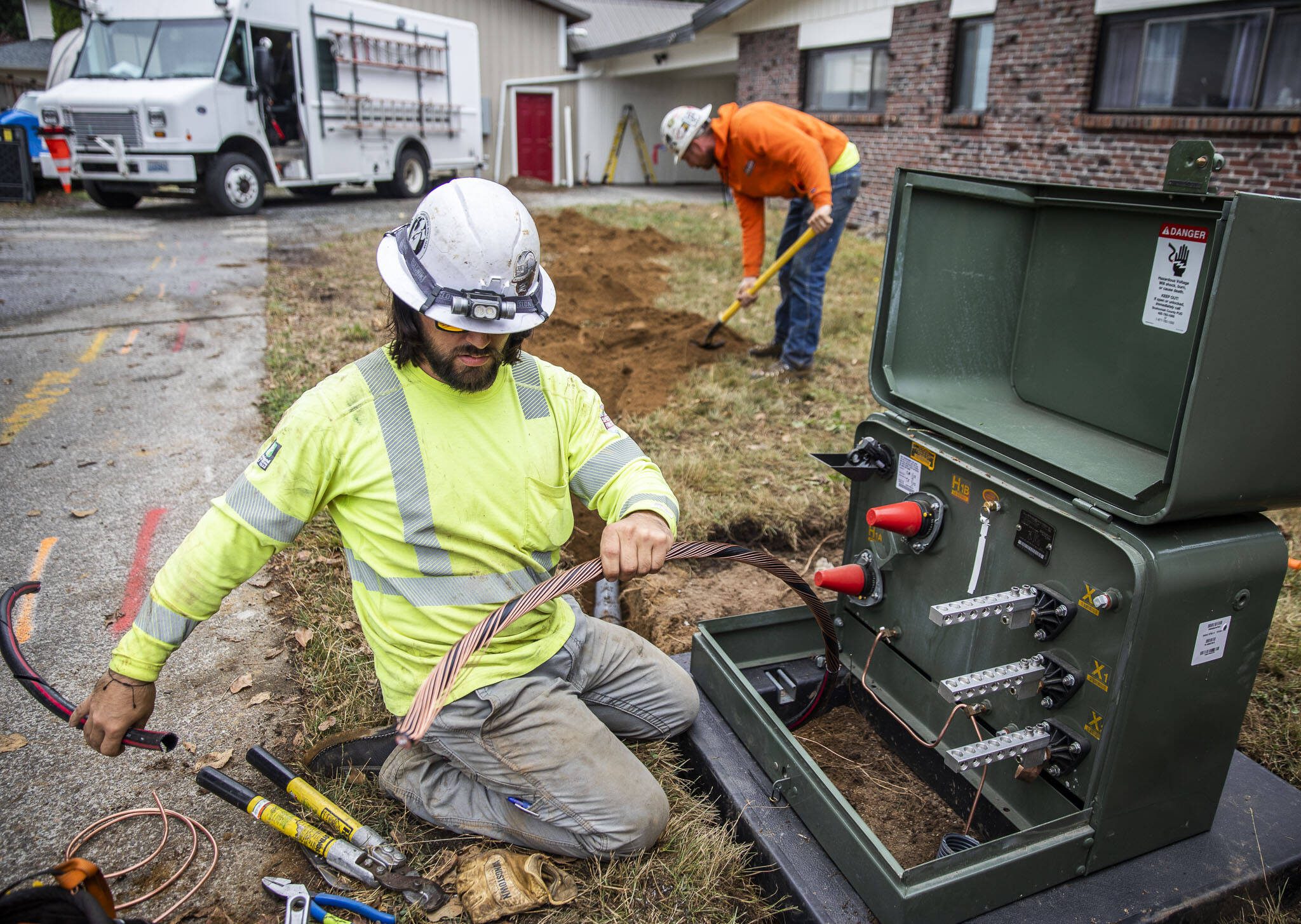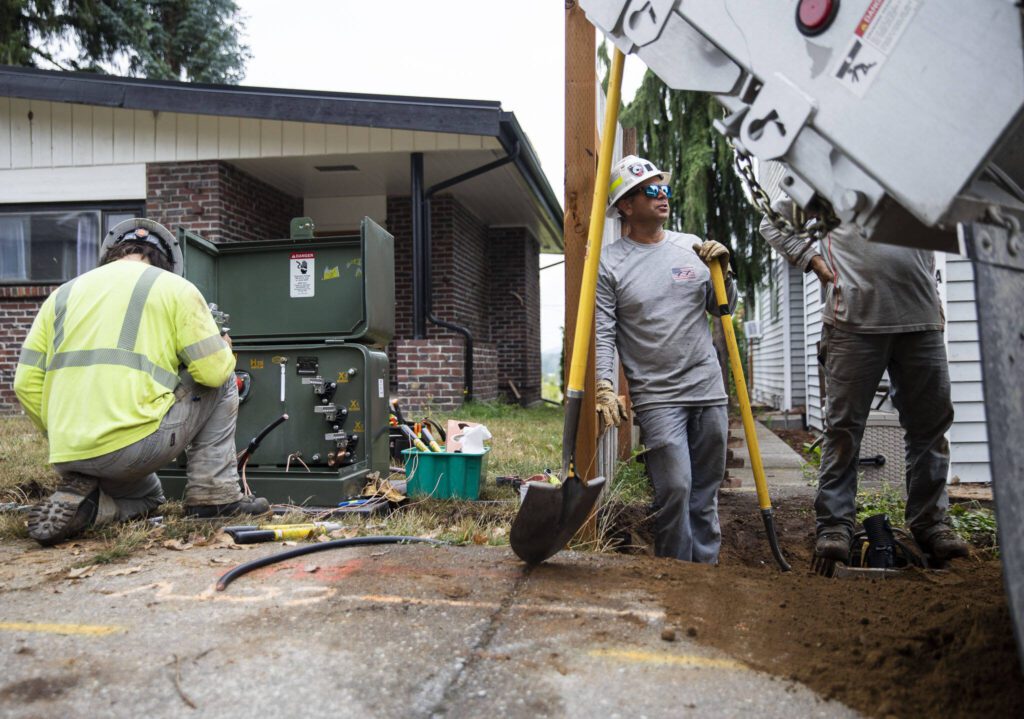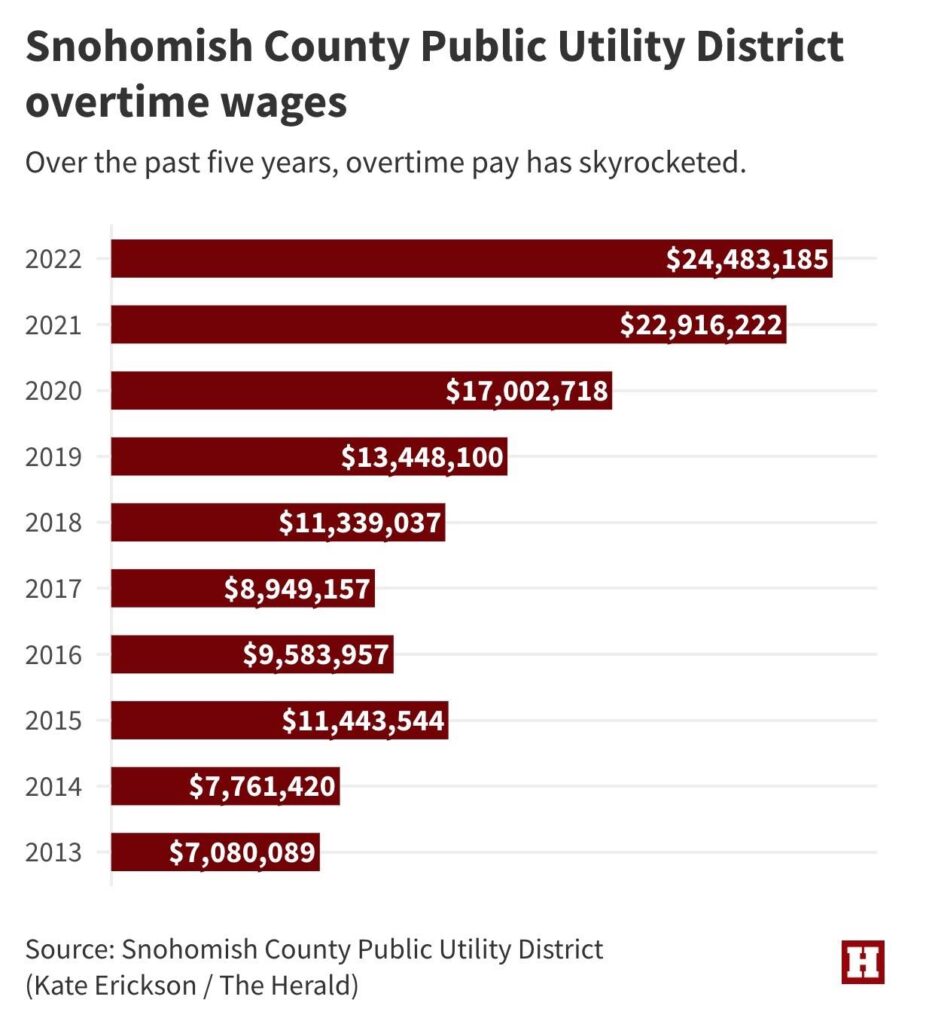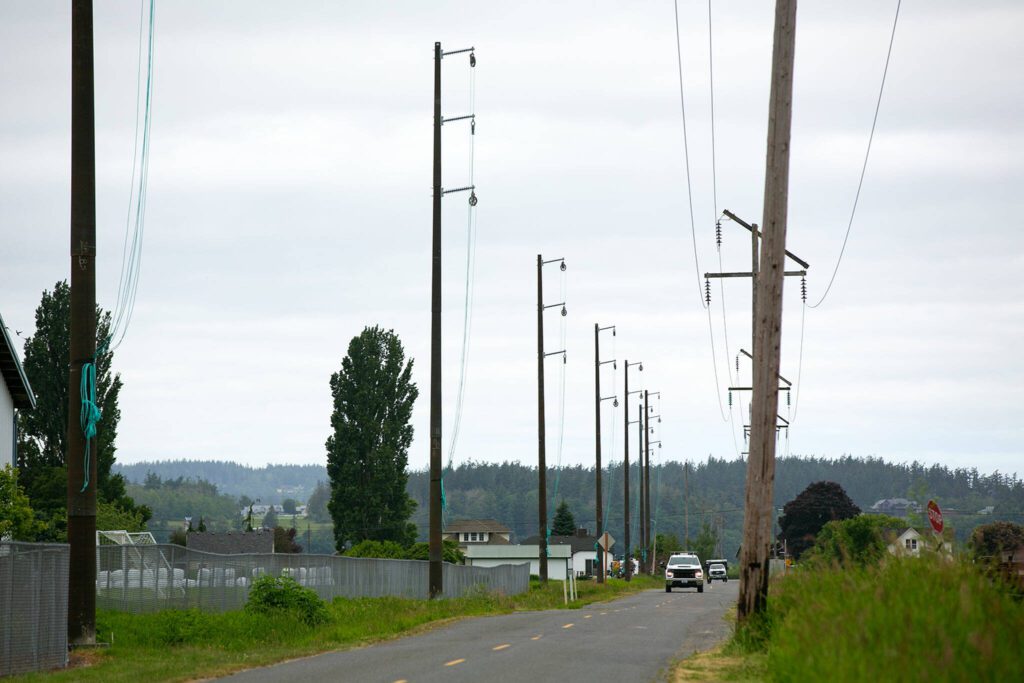EVERETT — Over the past six years, overtime pay at the Snohomish County Public Utility District skyrocketed to the point one lineworker last year made $695,972.67.
That’s more than the agency’s CEO, who received $600,000 in pay in 2022.
And overall, overtime pay has leapt from just under $9 million in 2017 to nearly $24.5 million in 2022.
The agency, the second biggest publicly owned utility in the state, provides electricity to over 373,000 homes and businesses, as well as water service to over 23,000.
PUD officials attributed the sudden rise in overtime to surging customer demand, a climate crisis causing more system-damaging storms, an understaffed workforce and changes to contracting policy that saved the utility millions of dollars by keeping more work in-house.
Line foreman Joe Rife is a 32-year PUD employee who accepts nine out of every ten overtime calls he gets, according to the PUD. Last year he made $150,000 in base pay. By accepting 142 emergency callouts he accrued 3,700 hours and an extra half a million dollars in overtime.
“He’s kind of like our last line of defense,” said Guy Payne, the PUD’s assistant general manager of distribution and engineering services. “We’re going to miss him when he retires someday.”
This year, Rife had already made almost $200,000 more than his base salary by mid-July. While Rife far outpaces his colleagues, at least eight other lineworkers made upwards of $300,000 last year.
By comparison, the average pay for all PUD employees last year was about $124,500, according to district records.
Rife declined to be interviewed, but wrote in an email: “I love my job and I love supporting our customers to keep the lights on.”
To the south, at Seattle City Light, overtime pay increased from $35.6 million in 2018 to $43.5 million last year, not nearly as sharp a rise as what the Snohomish County PUD has seen. A Seattle City Light spokesperson attributed its rise to increasing outages, rising base salaries and a staff shortage stemming from workers exiting due to the vaccine mandate.
Last month, Seattle City Light, serving over 470,000 customers, had just over 1,600 employees. The Snohomish County PUD had 1,164 workers at the beginning of the year.
‘Anytime he’s not sleeping’
To understand how the PUD can spend so much in overtime, it’s helpful to first know how overtime works there.
The PUD makes overtime voluntary, said Payne, the assistant general manager. Staffers can work as much double-pay overtime as they can get.
The utility tries to spread the wealth, so the callouts aren’t by seniority or mandatory, like elsewhere. Instead, the calls start with workers who have accrued the least overtime and end on those with the most. Though he usually gets called last, Rife accepts almost every time.
“Anytime he’s not sleeping, I think he’s working,” Payne said. “He’s stepping in and taking any call he can. If you knew him, you would never question his integrity. He is a true public servant.”
Under the union contract, a lineworker automatically gets two hours of overtime pay on a callout, even if they work less.
The contract also requires mandatory rest periods for those working overtime.
The increase in overtime hasn’t led to an accompanying rate increase for customers, PUD officials said. The utility raised rates 2.1% in April 2022 and another 2% this year, the first increases since 2017.
Utility leadership said at the time the increases were for energy efficiency projects and discounts for low-income customers.
‘A tough combination’
Three storms in the last two months of 2022 knocked out power for thousands of PUD customers and cost the utility between $9 and $10 million in overtime, more than a third of last year’s overtime costs, spokesperson Aaron Swaney said.
In 2017, the utility spent just $2.6 million on overtime during storms.
The district is seeking $10 million from the Federal Emergency Management Agency to reimburse overtime costs from one of the storms last November. The agency usually gets about 70% when seeking such federal reimbursements, Payne said, but payment might take two or three years.
Meanwhile, the simultaneous rapid growth of the county, and the rapid move to clean energy amid the climate crisis, has forced the agency to spend more to keep up.
The PUD had fallen behind on major projects, so in the past five years, the utility has had to ramp up fast to keep pace with the rising demand, Swaney said. The PUD is connecting 5,000 or 6,000 new customers each year, Payne noted.
At the same time, the district has to keep up with needs for air conditioning as well as electric appliances and vehicles in a warming region recognizing the need to get away from gas-guzzlers. That means paying staff to work more to keep expanding the grid. So overtime is needed just to avoid contributing to a backlog of everyday work, on top of constant unplanned outages, Payne said.
And while the whirlwind growth has brought the agency to the brink, the industry has also seen “unprecedented attrition,” Payne argued. A journeyman lineworker shortage, driven by aging baby boomers, has driven up pay and required more overtime.
“So right when we were in a time of growth and now we have labor shortages,” Payne said. “That’s a tough combination to try to navigate.”
The utility currently has about 90 lineworkers on staff. Closer to 100 would be ideal, Swaney said.
‘Let’s bet on our folks’
Another big driver of the rise in overtime lies in an obscure piece of state law revised in 2019.
Before 2019, state law required public utilities to contract out work on capital projects where the cost of the materials exceeded $150,000. That meant spending a lot less on in-house work. In 2017, for example, the county PUD spent upwards of $18 million on work its own employees could’ve done, Swaney said.
But four years ago, state lawmakers doubled the materials cost threshold to $300,000 and exempted costs for things like poles and wires, Swaney said. The local PUD lobbied for the bill, figuring it would save rate-payers money and keep the work up to the utility’s standards.
After that, General Manager John Haarlow decided to move work in-house.
“John made a decision: Let’s bet on our folks,” Payne said.
After that legislation, those outside contracts dropped from $18 million in 2017 to zero last year.
And because of that, the PUD could finish projects on its own, including a massive transmission line project on Camano Island to keep the lights on through emergencies. Previously, the utility would have had to contract out the work.
The same goes for the new Sky Valley substation in Monroe.
Baosen Zhang, a University of Washington professor who studies power systems, said the PUD’s challenges sound reasonable.
“Many regions in the US are going through similar challenges,” Zhang said in an email. “In addition to climate change, our grid infrastructure is aging … so that has contributed to unplanned outages.”
Payne doesn’t see the PUD’s rapid grid growth slowing anytime soon.
And staff attrition will likely continue apace, he said.
The assistant general manager said excessive overtime is just a part of the business until the labor shortage levels out. He hopes the utility can add staff to avoid burning out employees. But there’s a tradeoff between having enough employees to spread the work around, and having too many employees without enough work.
“We are in a unique time right now,” he said. “I really feel like we have been for four or five years. And I think it’ll continue for a few more years.”
Jake Goldstein-Street: 425-339-3439; jake.goldstein-street@heraldnet.com; Twitter: @GoldsteinStreet.
Talk to us
> Give us your news tips.
> Send us a letter to the editor.
> More Herald contact information.




























